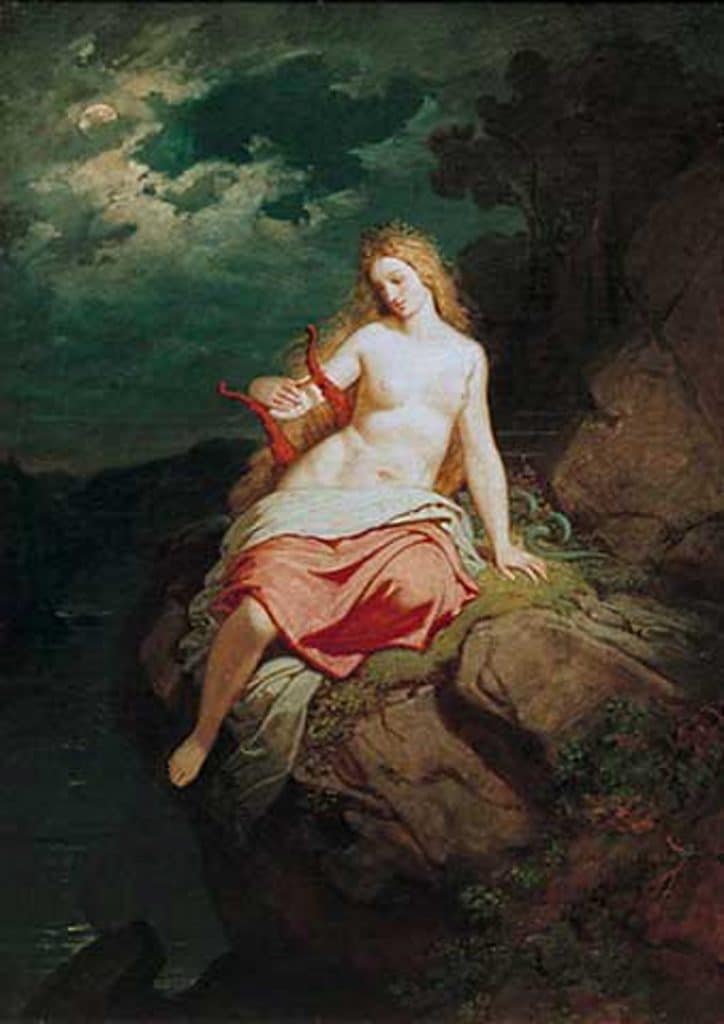At Rhine kilometre 555 there is a 123-metre-high slate rock, the world-famous Loreley Rock. Who doesn’t know the stories about the mysterious Loreley, which is said to have been responsible for many a shipwreck on the Rhine?

The Loreley rock is located in the Upper Middle Rhine Valley. The Rhine, which is initially about 300 metres wide, narrows here to about 145 metres. Directly at the Loreley, the Rhine is a good 160 metres wide and about 25 metres deep. The river winds in tight bends and there is a strong current here. Rock massifs rise up on both sides.
In the 1930s, attempts were made to widen the passage by blasting and thus make it less dangerous. Nevertheless, for many years skippers still had to get a pilot on board if they wanted to pass the Loreley.

Today, river traffic is regulated with the help of traffic lights to ensure safe travel. Nevertheless, caution is still required to this day. Especially at unusual water levels, shipping accidents still occur.
It is not yet clear where the rock got its name. As early as the Middle Ages, dwarves, nymphs or mountain spirits were held responsible for the dangerous currents and echoes on the Loreley rock. At that time, no one spoke of a woman named Loreley.

Over the years, so many stories and legends have grown up around the rock.
Sagas of the Loreley
There are many different and also very different variants of the Loreley sagas. Two of the most beautiful, in my opinion, are these:
The Abandoned Bride
The beautiful Loreley once loved the knight Eberhard. When he went to war, many men wooed Loreley, but she only wanted her Eberhard. Out of sheer amorous grief, some of the suitors killed themselves. This gave rise to the suspicion among the population that Loreley must be a witch. She was put on trial and the Archbishop of Cologne was to condemn her. The Archbishop took pity on the beautiful woman and sent her to a convent rather than to her death. On the way to the convent, Loreley asked to be allowed to take another look at her beloved’s castle on the Rhine. She was made to climb a rock and as she looked out over the Rhine, she saw Eberhard in a boat sailing towards the castle. She called his name loudly and Eberhard looked up at her, no longer paying attention to the rock and drove against it. The boat sank and Eberhard drowned. Out of sheer grief, Loreley jumped into the Rhine and was never seen again.

She combs her golden hair …
A long-haired blonde girl was sitting on the rock, combing her hair and singing a beguiling melody. The girl’s name was Loreley. The boatmen on the Rhine were enchanted by the young girl and could not take their eyes off her. They forgot to look at the Rhine, which has dangerous shoals and rocks at this point. Thus, some ships were wrecked and many skippers lost their lives.
Loreley in literature
In 1801, the ballad “Zu Bacharach am Rheine…” by Clemens Brentano was published. In it, he described a sorceress who robbed men of their wits with her beauty and brought them death. If you read the text further, it already bears a great deal of resemblance to the legend of “The Deserted Bride”. A few years later he published the Rhine Tales. Here, too, the theme of the Loreley can be found. This time, however, as a fairy figure. More details can be found in “Märchen vom Rhein und dem Müller Radlauf”.
The best-known version of the story was written by Heinrich Heine in 1824. His poem “Die Lore-Ley” was set to music by Friedrich Silcher in 1837 and became a popular folk song. In the 19th century, more than forty other versions were written, for example by Franz Liszt or Clara Schumann (Robert Schumann’s wife).

Loreley – Henrich Heine
Ich weiß nicht, was soll es bedeuten,
Dass ich so traurig bin;
Ein Märchen aus alten Zeiten
Das kommt mir nicht aus dem Sinn.
Die Luft ist kühl und es dunkelt,
Und ruhig fließt der Rhein;
Der Gipfel des Berges funkelt
Im Abendsonnenschein.
Die schönste Jungfrau sitzet
Dort oben wunderbar,
Ihr goldnes Geschmeide blitzet,
Sie kämmt ihr goldenes Haar.
Sie kämmt es mit goldenem Kamme
Und singt ein Lied dabei;
Das hat eine wundersame,
Gewaltige Melodei.
Den Schiffer im kleinen Schiffe
Ergreift es mit wildem Weh;
Er schaut nicht die Felsenriffe,
Er schaut nur hinauf in die Höh.
Ich glaube, die Wellen verschlingen
Am Ende Schiffer und Kahn;
Und das hat mit ihrem Singen
Die Loreley getan.
I don’t know what it’s supposed to mean,
That I’m so sad
A tale of old
That won’t get out of my mind.
The air is cool and it is dark,
And calmly flows the Rhine;
The summit of the mountain sparkles
In the evening sunshine.
The most beautiful virgin sits
Wonderful up there,
Her golden jewels are flashing,
She combs her golden hair.
She combs it with a golden comb
And sings a song while she does it;
That has a wondrous,
A mighty melody.
The skipper in the small ship
It seizes him with wild woe;
He looks not at the rocky reefs,
He only looks up to the heights.
I think the waves swallow up
In the end, skipper and barge;
And that with her singing
The Loreley did.
Visit to the Loreley Rock
The Loreley rock is one of the tourist highlights on the Rhine. In 2000, a large visitor centre with a museum and a restaurant opened here. Here you can find out everything about the Loreley and the region around the rock.

Since 2002, the Loreley Rock with the Upper Middle Rhine Valley has been a UNESCO World Heritage Site.
The Loreley Culture and Landscape Park opened in 2019. From a large visitor car park, for which a fee is charged, you can explore the grounds via various paths. The visit is free of charge and possible throughout.
I was able to discover part of the beautifully designed grounds during the visit accompanied by the 2021 reigning Loreley Tasmin Sophie Fetz. She first took us to a beautiful vantage point where winegrowers from the region were waiting for us. To be able to enjoy a wine tasting at such a beautiful spot is really something special.

We were allowed to taste 3 wines, a fine fruity Riesling (Handstreich), a rather down-to-earth Riesling (Felsenspiel) from a steep slope of the Middle Rhine and a dry Riesling (Meisterstück). Even though the wines were quite different, they had one thing in common, they were excellent in taste and what could be better than looking at the Romantic Rhine with a good Riesling from the Mittelrhein Riesling Charta.

Much too quickly, we continued to the “official residence” of the Loreley. High above the Rhine there is a rock on which not only the reigning Loreley regularly takes a seat and combs her hair. Everyone is allowed to sit here and whoever likes may also sing. Maybe the boatmen on the Rhine will hear it.

The view from the viewing platform is spectacular and the Rhine with its surrounding rocky landscape is revealed in all its beauty.
Loreley Visitor Centre
Auf der Loreley (oberhalb von St. Goarshausen)
Loreley 7
56348 Bornich
Visitor centre opening hours:
March – October
daily 10 – 17 h
November until February
daily 11 – 16 h
Entrance fees visitor centre:
free
Entrance fee Loreley Rock:
free
The visit to the Loreley Rock was an item on the agenda of a blogger event organised by Antje Zimmermann and the Romantic Rhine Tourism.








Leave a Reply